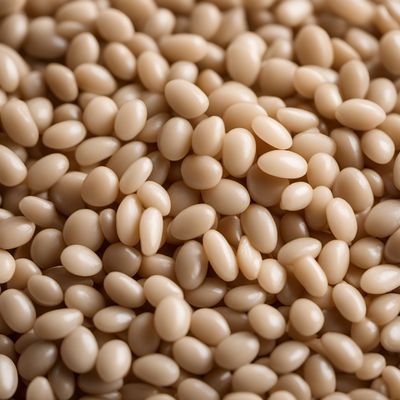
Ingredient
Soyabeans for consumption (dry)
The Versatile Legume
Soyabeans, also known as edamame when harvested young, are a versatile legume widely used in various cuisines around the world. With a creamy texture and a subtly nutty flavor, they can be enjoyed in both savory and sweet dishes. Soyabeans are highly nutritious, packed with protein, fiber, and essential vitamins and minerals.
Origins and history
Soyabeans have been cultivated in East Asia for thousands of years and are an integral part of Asian cuisine. They were introduced to the Western world in the 18th century and have since gained popularity globally. Soyabeans are not only valued for their culinary uses but also for their role in plant-based protein production.
Nutritional information
Soyabeans are a nutritional powerhouse, rich in protein, fiber, iron, calcium, and essential vitamins like folate and vitamin K. They are also a good source of healthy fats and antioxidants. A 1-cup serving of cooked soyabeans provides approximately 300 calories.
Allergens
Soyabeans may cause allergic reactions in individuals with soy allergies. It is important to read labels carefully and avoid consuming soyabeans or products containing soy if allergic.
How to select
When selecting dry soyabeans, look for ones that are plump, firm, and free from mold or insect damage. Avoid beans that appear wrinkled or discolored. Opt for organic or non-GMO varieties if desired. Store dry soyabeans in a cool, dry place in airtight containers to maintain their quality and prevent moisture absorption.
Storage recommendations
To preserve the freshness of dry soyabeans, store them in a cool, dry place, such as a pantry or cupboard. Keep them in airtight containers to protect them from moisture and pests. Properly stored, dry soyabeans can last for up to a year.
How to produce
Soyabeans can be grown at home by planting soybean seeds in well-drained soil and providing them with adequate sunlight and water. With proper care, they can be harvested when the pods are fully matured and the beans have hardened. The beans can then be dried for long-term storage or used immediately in various recipes.
Preparation tips
Before using dry soyabeans, they need to be soaked overnight or boiled for a few minutes to soften them. They can then be used in soups, stews, stir-fries, salads, or even ground into flour for baking. Roasted soyabeans make a nutritious snack, while edamame can be enjoyed steamed and lightly salted as an appetizer or side dish.
Culinary uses
Soyabeans are incredibly versatile and used in a wide range of dishes worldwide. They are commonly used in Asian cuisines, such as stir-fries, tofu, miso soup, and soy milk. In Western cuisines, they are often used in vegetarian and vegan recipes as a meat substitute or added to salads, grain bowls, and dips.
Availability
Soyabeans are cultivated and consumed in many countries, including China, Japan, South Korea, Indonesia, the United States, Brazil, and Argentina. They are also widely available in most grocery stores and supermarkets around the world.
More ingredients from this category » Browse all

Runner beans (dry)
The Versatile Legume: Exploring the World of Dry Runner Beans

Yardlong beans (dry)
The Nutrient-Packed Legume: Yardlong Beans

Borlotti or other common beans (dry)
The Versatile Dried Beans

Mung beans (dry)
The Mighty Green Legume

Lablab beans (dry)
The Versatile Legume: Lablab Beans

Broad beans (dry)
Hearty and Nutritious: The Dried Legume Powerhouse

Guar beans (dry)
Versatile Legumes: Guar Beans

Monantha vetches (dry)
The Versatile Monantha Vetches

Ervils (dry)
The Nutritional Powerhouse: Exploring the Versatility of Dry Ervils

Rice beans (dry)
The Versatile Powerhouse: Rice Beans

Jack beans (dry)
The Versatile Legume: Unveiling the Wonders of Jack Beans

Black eyed peas (dry)
The Lucky Legume
